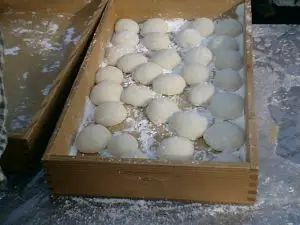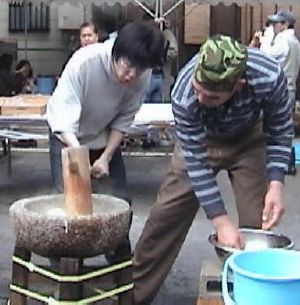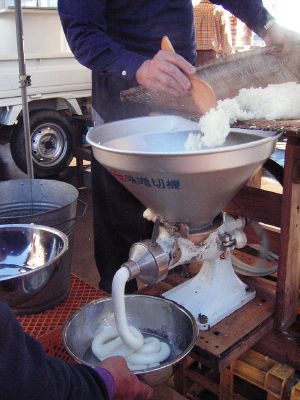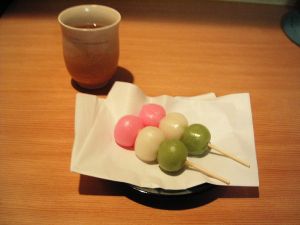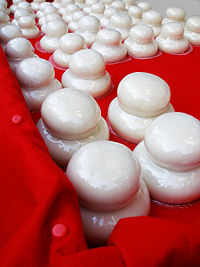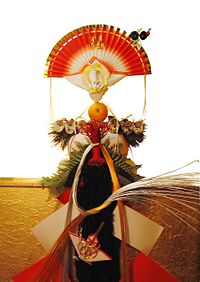Mochi
- For other uses, see Mochi (disambiguation).
Mochi (Japanese: 餅; Chinese: 麻糬) is a Japanese rice cake made of glutinous rice pounded into paste and molded into shape. In Japan it is traditionally made in a ceremony called mochitsuki. While also eaten year-round, mochi is a traditional food for the Japanese New Year and is commonly sold and eaten during that time.
Mochi is similar to the Chinese rice cake nian gao; however, mochi is shaped from cooked glutinous rice right after it is pounded, whereas nian gao is steamed directly to its final form from a batter made of uncooked glutinous rice flour. In the Philippines, it is called palitao in Tagalog and is coated with sesame seeds and grated coconut.
Mochitsuki
Mochitsuki is the traditional mochi-pounding ceremony in Japan.
- Polished glutinous rice is soaked overnight and cooked.
- The cooked rice is pounded with wooden mallets (kine) in a traditional mortar (usu). Two people will alternate the work, one pounding and the other turning and wetting the mochi. They must keep a steady rhythm or they may accidentally injure one another with the heavy kine.
- The sticky mass is then formed into various shapes (usually a sphere or cube).
Mochi may also be made in an automatic mochi machine, similar to a breadmaker. In fact, mochi can be made using a breadmaker if the rice is soaked and steamed separately and the machine can be started in a kneading mode.
Making mochi at home is possible without an automatic machine. Use a bamboo steamer or other apparatus that the sweets will not stick to while steaming. Add only enough water to allow the flour to stick together, form a small circle of the dough, then put a small amount of bean paste in the center. Close the dough over the paste and place in the steamer until the mochi congeals. Immediately upon removing the mochi from the steamer, coat the mochi in more sweet rice flour to prevent it from sticking to the hands of the maker.
Popular uses for mochi
Confectionery
Many types of traditional wagashi (Japanese traditional sweets) are made with mochi. For example, daifuku is a soft round mochi stuffed with sweet filling, such as sweetened red bean paste (an) or white bean paste (shiro an). Ichigo daifuku is a version containing a whole strawberry inside.
Kusa mochi is a green variety of mochi flavored with yomogi (mugwort). When daifuku is made with kusa mochi, it is called yomogi daifuku.
Ice cream
Small balls of ice cream are wrapped inside a mochi covering to make mochi ice cream. In Japan this is manufactured by the Korean conglomerate, Lotte under the name Yukimi Daifuku, "snow-viewing daifuku". In the United States the grocery chain Trader Joe's, H Mart, and Mollie Stone's sell mochi ice cream in flavors of chocolate, mango, green tea, coffee, vanilla, and strawberry. It is popular in California, Hawaii, Atlanta, Georgia and Portland, Oregon. A Japanese-owned company (Mikawaya) operating in Los Angeles makes Mochi Ice Cream, which is the variety that is sold by Trader Joe's and Mollie Stone's. Los Angeles and New York's Pinkberry yogurt also offers mochi as a "secret menu" topping on their desserts. It's not on the menu and kept in their fridges but if you ask for it they will get it for you.
Soup
- Oshiruko or ozenzai is a sweet azuki bean soup with pieces of mochi. In winter, Japanese people often eat it to warm themselves.
- Chikara udon (meaning "power udon") is a dish consisting of udon noodles in soup topped with toasted mochi.
New Year specialties
- Kagami mochi is a New Year decoration, which is traditionally broken and eaten in a ritual called Kagami biraki (mirror opening).
- Zōni soup is a soup containing rice cakes. Zoni is also eaten on New Year's Day. In addition to mochi, zoni contains vegetables like honeywort, carrot, and red and white colored boiled kamaboko.
- Kinako mochi is a mochi dish that is traditionally made on New Year's Day for luck. This style of mochi preparation includes roasting the mochi over a fire or stove, and then dipping it into a mixture of soy sauce, water and sugar, before finally briefly coating it in kinako (soy flour).
Other
- Dango is a Japanese dumpling made from mochiko (rice flour).
- Warabimochi is not true mochi, but a jelly-like confection made from bracken starch and covered or dipped in kinako (sweet toasted soybean flour). It is popular in the summertime, and often sold from trucks, not unlike ice cream trucks in Western countries.
- More recently, "Moffles" (a waffle like machine used to cook Mochi's) has been introduced with much fanfare. Ref: http://search.japantimes.co.jp/cgi-bin/nn20080319f1.html
Notes
See also
- Tangyuan
- Chè xôi nước
To make the rice cake "mochi" for 4 people, we need:
- 2 cups of brown rice
- 1 to 1.25 cups of water per cup of rice
- a pinch of seasalt per cup rice
Wash the rice and soak for a couple of hours or throughout the night. Cook the rice in a pressure pan. Grind the cooked rice in a mortar, just as long as when the grain is completely fluid and sticky. This will take at least 30 minutes of griding when done by hand. Shape the mash into 2 centimeter squares. Put the rice squares onto an oiled plate and allow to dry for 1 to 2 days. Keep covered in a cold dry room or in the refrigerator. After this, roast the squares for 5 minutes in a pan.
Dango (団子) is a Japanese dumpling made from mochiko (rice flour), related to mochi. It is often served with green tea.
Dango are eaten year-round, but the different varieties are traditionally eaten in given seasons. Three to four dango are often served on a skewer. One variety of dango from Hokkaidō is made from potato flour and baked with shoyu (soy sauce).
Types of dango
There are many different varieties of dango which are usually named after the various seasonings served on or with it.
- Anko: Commonly known as (sweetened) red bean paste, while ingredients other than azuki are used on rare occasions. An-Dango is the most popular flavor in Japan.
- Bocchan dango: Dango that has three colors. One is colored by red beans, the second by eggs, and the third by green tea.
- Chichi dango: Slightly-sweet light treats usually eaten as a dessert.
- Goma: sesame seeds. It is both sweet and salty.
- Kinako: A toasted soy flour.
- Kushi dango: Dangos held by a skewer
- Mitarashi: A syrup made from shouyu (soy sauce), sugar and starch.
- Teppanyaki: Dango on a skewer with a tangy teppanyaki taste.
Derived terms
A common Japanese proverb "Hana yori dango" (花より団子 which translates as "dumplings rather than flowers") refers to a preference for practical things rather than aesthetics.
Dango is used internationally amongst go players as a derogatory term for an inefficient, dumpling-like cluster of stones in a go game. It is also the name of a go variant invented in 1991.
A hairstyle consisting of dango-like buns on either side of the head is sometimes known as odango.
Rise in popularity
- In 1999, dango experienced a surge of popularity in Japan following the release of a song entitled "Dango san kyōdai" (three dango brothers). The CD single sold over 2.9 million copies, making it the 4th best selling CD single in Japan during 1968-2006.
- In the extremely popular Japanese film series Otoko wa Tsurai yo, the family of lead character Kuruma Torajirō (Tora-san) operated a small traditional dango shop in Shibamata, Katsushika, Tokyo.
- In the anime series Sailor Moon, the protagonist Usagi Tsukino is humourously referred to as odango-atama, "dumpling-head", because of her hairstyle.
- In the anime series Clannad, dango are the main focus of the ending theme song, titled "Dango Daikazoku" (literally translated as Great Family of Dango or Big Dango Family). The ending video features personification of many types of dango as they act according to the song. In the series (also in the original visual novel), the main heroine Nagisa Furukawa is very fond of the personifications of dango which she finds to be cute, and likes to sing the beginning of "Dango Daikazoku" which merely consists of the word "dango" being repeated several times.
- In Naruto, Mitarashi Anko was seen eating dango during the second test of the Chuunin exam. Her name is also derived from the sweet red bean paste used in popular dango.
- Also in Naruto - apart from being associated with weasels, Itachi Uchiha is also loosely associated with Dango by fans.
- In the manga and anime series of "Dā! Dā! Dā!" or also popular as "UFO Baby" in some countries, the babysitter of Ruu, Wannya, is a crazy lover of dango, most notably Mitarashi Dango.
- In the Fullmetal Alchemist Anime, you see Edward Elric eating four skewered dangos.
- In the D.Gray-man series Allen Walker's favorite food is mitarashi dango.
- In the Mokke series, Mitarashi Dango is often eaten by one of the main characters, Mizuki.
- In the anime series Samurai Champloo, dangos are usually the only food affordable for the main characters.
- In the popular manga series Fruits Basket, Hanajima and her brother are usually seen eating dango.
- Hana Yori Dango is a famous Japanese drama, named after the proverb.
See also
- Wagashi, traditional Japanese confectionery
Kagami mochi (鏡餅), literally mirror rice cake, is a traditional Japanese New Year decoration. It usually consists of two[1][2][3][4] round mochi (rice cakes), the smaller placed atop the larger, and a daidai (a Japanese bitter orange) with an attached leaf on top. In addition, it may have a sheet of konbu and a skewer of dried persimmons under the mochi. It sits on a stand called a sanpō (三宝) over a sheet called a shihōbeni (四方紅), which is supposed to ward off fires from the house for the following years. Sheets of paper called gohei (御幣) folded into lightning shapes similar to those seen on sumo wrestler's belts are also attached.
The kagami mochi first appeared in the Muromachi period (14th-16th century). The name kagami ("mirror") is said to have originated from its resemblance to an old-fashioned kind of round copper mirror, which also had a religious significance. The reason for it is not clear. Explanations include mochi being a food for sunny days,[2] the 'spirit' of the rice plant being found in the mochi,[1][2] and the mochi being a food which gives strength.[2]
The two mochi discs are variously said to symbolize the going and coming years,[2] the human heart,[2] "yin" and "yang", or the moon and the sun.[3] The "daidai", whose name means "generations",[4] is said to symbolize the continuation of a family from generation to generation.[1]
Traditionally the kagami mochi was placed in various locations throughout the house.[3] Nowadays it is usually placed in a household Shinto altar, or kamidana. It has also been placed in the tokonoma, a small decorated alcove in the main room of the home.
Contemporary kagami mochi are often pre-moulded into the shape of stacked discs and sold in plastic packages in the supermarket. A mikan or a plastic imitation daidai is often substituted for the original daidai.
Variations in the shape of kagami mochi are also seen.[3] In some regions, three layered kagami mochi are also used. The three layered kagami mochi are placed on the butsudan or on the kamidana. There is also a variant decoration called an okudokazari placed in the centre of the kitchen or by the window which has three layers of mochi.[3]
It is traditionally broken and eaten in a Shinto ritual called kagami biraki (mirror opening) on the second Saturday or Sunday of January. This is an important ritual in Japanese martial arts dojos.[5] It was first adopted into Japanese martial arts when Jigoro Kano, the founder of judo, adopted it in 1884, and since then the practice has spread to aikido, karate and jujutsu studios.
Credits
New World Encyclopedia writers and editors rewrote and completed the Wikipedia article in accordance with New World Encyclopedia standards. This article abides by terms of the Creative Commons CC-by-sa 3.0 License (CC-by-sa), which may be used and disseminated with proper attribution. Credit is due under the terms of this license that can reference both the New World Encyclopedia contributors and the selfless volunteer contributors of the Wikimedia Foundation. To cite this article click here for a list of acceptable citing formats.The history of earlier contributions by wikipedians is accessible to researchers here:
- Mochi history
- Cookbook:Mochi history
- Dango history
- mochi&oldid=68.183.183.210 Kagami mochi mochi&action=history history
The history of this article since it was imported to New World Encyclopedia:
Note: Some restrictions may apply to use of individual images which are separately licensed.
- ↑ 1.0 1.1 1.2 Guide to Kagami Mochi from "Manner Bijin" ((Japanese)
- ↑ 2.0 2.1 2.2 2.3 2.4 2.5 Kagami mochi FAQ (Japanese)
- ↑ 3.0 3.1 3.2 3.3 3.4 Question and answer on three layered kagami mochi from Tokyo Gas (Japanese)
- ↑ 4.0 4.1 Kōjien dictionary. Various Japanese dictionaries, including the Kōjien, testify that the kagami mochi has two layers of mochi. Three or more layers is not mentioned.
- ↑ Kagami Biraki: Renewing the Spirit

